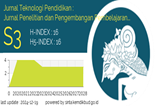EDUCATIONAL INSTITUTION’S USE OF SOCIAL MEDIA: A CASE STUDY FROM EDUTOPIA
Abstract
This is a case study that elaborates how George Lucas Educational Foundation (GLEF), an educational institution that is broadly known as Edutopia, employes social media to advocate their learning strategies. Social media usage decision is determined by the strategic goals that organizations want to accomplish. Organizations should decide, whether they need to pick from existing social media platforms, to establish their own applications, or to use both. In this regards, Edutopia uses both its own-developed and existing social media platforms. Therefore, this study is aimed to: 1) elaborate the relevant advantages of each type of those platforms to its mission, 2) to study opportunities that Edutopia has to build relationship with its users though its forum and blogs, and 3) to analyze the functions of social media to understand the appropriateness of using different social media platforms. The data were collected using interview, observation, and documenting from April until June, 2014 and were analyzed using pattern matching logic. The results showes that both own-developed and existing platforms are beneficial for Edutopia as they seem to have different characteristics, target users, as well as different level of engagement. The study also showes that Edutopia’s user engagement level was significantly high which meant Edutopia has been using their various social media channel to effectively build its community. Finally, Edutopia has functionally utilizes its social media to bring its mission to: 1) document , 2) disseminate, and 3) advocate its learning solutions to teachers, parents, administrators, education leaders, and other stakeholders.
Keywords: social media, community building.
Full Text:
PDFReferences
Creswell, J. W. (1998). Qualitative Inquiry and Research Design: Choosing Among Five Tradition. (London: SAGE Publications, 1998), hlm. 37-38
Duggan, M., & Smith, A. (2014). Social Media Update 2013. Pew Research Center’s Internet & American Life Project. Retrieved from http://www.pewinternet.org/2013/12/30/social-media-update-2013/
Durant, J. (1999). Participatory technology assessment and the democratic model of the public understanding of science.Science and Public Policy, 26(5), 313-319.
Edelstein, M. (2010). How to: Evaluate Your Social Media Plan. Mashable. Retrieved from http://mashable.com/2010/06/25/evaluate-social-media-plan/
Edutopia. (2014, May 30). Wikipedia, the free encyclopedia. Retrieved from http://en.wikipedia.org/w/index.php?title=Edutopia&oldid=581360447
Edutopia. (n.d.). Edutopia. Retrieved June 2, 2014, from http://www.edutopia.org/
Kaplan, A. M., & Haenlein, M. (2010). Users of the world, unite!: The challenges and opportunities of social media. ScienceDirect, 53, 59-68. doi:10.1016/j.bushor.2009.09.003
Kent, M. L. (2008). Critical analysis of blogging in public relations. Public Relations Review, 34(1), 32-40.
Kent, M. L., & Taylor, M. (1998). Building dialogic relationships through the world wide web. Public Relations Review, 24(3), 321-334. doi: http://dx.doi.org/10.1016/S0363-8111(99)80143-X
Lovejoy, K., & Saxton, G. D. (2012). Information, community, and action: How nonprofit organizations use social media.
Journal of Computer-Mediated Communication, 17, 337-353. doi: doi:10.1111/j.1083-6101.2012.01576.x
Mergel, I., & Bretschneider, S. I. (2013). A Three-Stage Adoption Process for Social Media Use in Government. Public Administration Review, 73(3), 390-400. doi: 10.1111/puar.12021
Michaelidou, N., Siamagka, N. T., & Christodoulides, G. (2011). Usage, barriers and measurement of social media marketing: An exploratory investigation of small and medium B2B brands. Industrial Marketing Management, 40(7), 1153-1159. doi: 10.1016/j.indmarman.2011.09.009
Vaughan, P. (2012). 8 Questions to Evaluate if That New Social Network is Worth Your Company’s Time. Inbound Marketing. Retrieved June 18, 2014, from http://blog.hubspot.com/blog/tabid/6307/bid/33213/8-Questions-to-Evaluate-if-That-New-Social-Network-is-Worth-Your-Company-s-Time.aspx
Waters, R. D., Burnett, E., Lamm, A., & Lucas, J. (2009). Engaging stakeholders through social networking: How nonprofit organizations are using Facebook. Public Relations Review, 35, 102–106.
Yin, R. K. (1989). Case Study Research Design and Methods. Washington: COSMOS Corporation
DOI: https://doi.org/10.33394/jtp.v2i2.594
Refbacks
- There are currently no refbacks.
Copyright (c) 2022 Muhtar Ahmad

This work is licensed under a Creative Commons Attribution-ShareAlike 4.0 International License.
This Journal has been Indexed by:
Jurnal Teknologi Pendidikan
ISSN: 2656-1417 (Online)
ISSN: 2503-0620 (Print)
Published by Program Studi Teknologi Pendidikan, FIPP
Universitas Pendidikan Mandalika
Email: [email protected]

This work is licensed under a Creative Commons Attribution-ShareAlike 4.0 International License.















.png)






